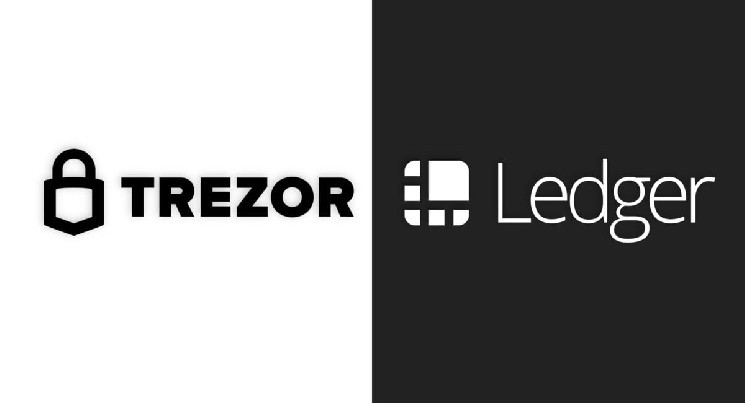Trezor vs Ledger: Which Should You Pick in 2023?

Trezor and Ledger are the largest cryptocurrency hardware wallet manufacturers in the world. Although they both offer great products for protecting digital assets, there are considerable differences between them from a user experience, hardware, and software perspective.
This article will help you understand the main differences between Trezos and Ledger wallets, based on factors such as cost, connectivity, security, and, supported cryptocurrencies.
It is worth noting that there are no clear winners when it comes to Ledger vs Trezor, as both support thousands of cryptocurrencies and offer robust security. The decision of which one is “better” will thus primarily depend on your own personal circumstances and particular use cases.
Trezor vs Ledger – Side-by-side comparison
Trezor and Ledger are widely known for making the best cryptocurrency hardware wallets. They share many similarities, but there are also quite a few differences between the two in terms of accessibility, price, and, particularly, software integrations. Let’s see how Trezor and Ledger compare at a glance.
| Trezor | Ledger | |
|---|---|---|
| Price | $69 to $219 | $79 to $279 |
| Supported Cryptocurrencies | 1300+ | 5500+ |
| Security | CE and RoHS certified, 2FA | Certified Secure Element (CC EAL5+), 2FA |
| Wallet Software | Trezor Suite | Ledger Live |
| 3rd Party Wallet Support | Yes | Yes |
| Mobile Support | No | iOS and Android |
Who should choose a Trezor hardware wallet?
Trezor is best for users who might already be familiar with cryptocurrencies and don’t necessarily need access to the beginner educational content that Ledger provides. If the following describes you, then a Trezor hardware wallet is the right choice for you:
- You don’t plan on using your crypto wallet with a mobile device
- You prefer open-source solutions
- You value having a bigger screen and a lighter design
Get a Trezor Wallet
Who should choose a Ledger hardware wallet?
Ledger is hands down the best option if you are looking for a cryptocurrency wallet that is easy to set up and works with mobile devices. If the following describes you, then a Trezor hardware wallet is the right choice for you:
- You prefer a metallic and slightly heavier design over a plastic body
- You want to use your crypto wallet when on the go
- You need seamless integrations with DeFi and NFTs
Get a Ledger Wallet
Price point
Trezor has two hardware wallets in its lineup – the Trezor Model T and Trezor Model One. The Model T starts is the more expensive option, starting at $219. Meanwhile, the Model One starts at $69. Both Trezor devices integrate seamlessly with Trezor Suite, a software solution for managing coins and tokens.
The more expensive Model T comes with a touchscreen, USB-C, and the ability to anonymize transactions with CoinJoin, a trustless method for combining multiple BTC payments from multiple spenders into a single transaction. Moreover, the Model T features PIN and direct passphrase entry on the touchscreen, which offers extra security.
Ledger devices start at $79 and can reach a price tag of up to $279. The least expensive and basic option in Ledger’s crypto hardware wallet lineup is Ledger Nano S Plus, which starts at $79. The Nano S Plus is a successor to the popular Nano S model, which has recently been discontinued but is still available at some retailers. The newer Nano S Plus has more onboard storage and other improvements over the Nano S.
If you are looking for the best mobile support, then the Ledger Nano X at $149 is your best choice, as the device allows you to connect to an iOS or Android device using either a cable or Bluetooth connection.
Finally, there is the recently announced Ledger Stax, arguably the most advanced cold storage device on the market. At $279, the Ledger Stax has all the features of the Nano S Plus and Nano X, but comes with a large E-Ink touchscreen which makes it much easier to manage crypto assets on the physical device itself. The Ledger Stax has been sold out during the preorder. It will start shipping later this year.
Features

Both Trezor and Ledger hardware devices are equipped with all the essentials required for safely storing private keys and, thus, securely managing crypto assets.
In the features department, it’s hard to give a nudge to Ledger – the Nano X and Stax have Bluetooth support. Moreover, the Ledger Stax comes with wireless charging, a curved E-Ink display, and a customizable lock screen.
The Trezor Model T has one distinct advantage over other wallet models, as it comes with a large and bright touchscreen LCD with a resolution of 128×64 px. While this is less than the Ledger Stax, Model T’s bright display and high responsiveness make it a very solid choice for power users.
In the budget category, consisting of the Ledger Nano S Plus and Trezor Model One, there aren’t big differences. Both devices come equipped with two physical buttons that allow users to interact and connect their wallets to supported desktop operating systems. The S Plus offers mobile connectivity as well (although only via a cable), whereas the Model One does not.
Security

When it comes to security, both Trezor and Ledger use certified hardware and software technologies to make their devices as secure as possible.
The Trezor Model Tuses advanced Shamir backups, a new security standard that diminishes the effects of two primary security risks to your recovery seed: theft and destruction. In addition, the Trezor Model T uses FIDO2 and U2F authentication standards. Finally, anonymization of transactions via CoinJoin is available as well.
The Trezor Model One is not as feature packed as its bigger brother – it offers standard backups instead of Shamir backups and has no support for CoinJoin’s anonymous transactions. The Trezor Model One lacks the on-device PIN protection of the more expensive Trezor Model T as well.
All Ledger models use a secure element ship with CC EAL5+ certification. In addition, all can be locked and unlocked using physical buttons and use a 24-word secret recovery phrase for backups.
Connectivity with mobile devices
Trezor offers no native support for mobile devices, although an app for Android is in the pipeline. Meanwhile, mobile device support is where Ledger shines.
All Ledger wallets can be connected to mobile devices via cable, or via Bluetooth in the case of more expensive Nano X and Stax. While all three devices support Apple’s products with Android 9 or higher, the Ledger Nano S Plus doesn’t ship with iOS support.
The mobile connectivity allows users to connect their Ledgers with the Ledger Live software on the mobile device to buy, sell, and transfer crypto assets and NFTs, and interact with DeFi with an additional layer of security.
Software wallets

Both Trezor and Ledger have their own version of a software platform. In the case of Trezor, that’s Trezor Suite, and in the case of Ledger, that’s Ledger Live.
Trezor Suite and Ledger Live are essentially software wallets that allow users to manage their assets. They both feature options for selling and buying crypto as well.
Trezor Suite is available on Apple, Windows, and Linus desktops, as well as via a browser app. Meanwhile, Ledger Live also supports all three big desktop operating systems, but features support for iOS and Android as well.
In addition to the native wallet solutions, both Trezor and Ledger allow users to connect to third-party wallets. Ledger provides a full list of compatible third-party wallets, whereas its competitor provides a sample list of supported third-party wallets and apps for Trezor, but not the whole list.
Supported cryptocurrencies
Both Trezor and Ledger support all the major coins and tokens, including Bitcoin, Ethereum, Cardano, Solana, Polkadot, and more.
In total, Ledger support over 5,500 cryptocurrencies. However, that includes assets that are supported only via third-party wallets and services. Still, Ledger Live supports more than 500 coins natively, more than enough for most crypto users.
Trezor supports over 1,300 cryptocurrencies. While that might seem lower than Ledger at first glance, the difference is that the more than a thousand coins supported by Trezor are supported natively via Trezor Suite, and don’t require any third-party integrations.
The bottom line – Ledger has a small edge in terms of features and user-friendliness
Whether you go for Trezor or for Ledger, both manufacturers offer supreme build quality and a rich set of features necessary to store your crypto assets securely.
However, with Ledger’s ability to connect with iOS and Android devices, as well as a more beginner-friendly interface, it’s hard not to give a small edge to Ledger overall.
Buy a Ledger Hardware Wallet
As long as you safely back up your recovery phrase and don’t disclose it to anyone, your cryptocurrencies will be protected very well. However, you can use a purpose-made metal device for more secure seed phrase storage.







 Bitcoin
Bitcoin  Ethereum
Ethereum  Tether
Tether  USDC
USDC  Dogecoin
Dogecoin  Cardano
Cardano  TRON
TRON  Bitcoin Cash
Bitcoin Cash  Chainlink
Chainlink  Polygon
Polygon  Litecoin
Litecoin  LEO Token
LEO Token  Dai
Dai  Hedera
Hedera  Ethereum Classic
Ethereum Classic  Cronos
Cronos  Cosmos Hub
Cosmos Hub  Stacks
Stacks  Stellar
Stellar  OKB
OKB  Maker
Maker  Monero
Monero  Theta Network
Theta Network  Algorand
Algorand  NEO
NEO  Gate
Gate  KuCoin
KuCoin  EOS
EOS  Tezos
Tezos  Synthetix Network
Synthetix Network  IOTA
IOTA  Bitcoin Gold
Bitcoin Gold  Tether Gold
Tether Gold  TrueUSD
TrueUSD  Enjin Coin
Enjin Coin  Zilliqa
Zilliqa  Siacoin
Siacoin  Ravencoin
Ravencoin  Holo
Holo  0x Protocol
0x Protocol  Qtum
Qtum  Basic Attention
Basic Attention  Zcash
Zcash  Dash
Dash  NEM
NEM  Decred
Decred  Ontology
Ontology  Lisk
Lisk  Waves
Waves  DigiByte
DigiByte  Numeraire
Numeraire  Nano
Nano  Pax Dollar
Pax Dollar  Status
Status  Hive
Hive  Steem
Steem  Huobi
Huobi  OMG Network
OMG Network  BUSD
BUSD  Ren
Ren  Bytom
Bytom  Bitcoin Diamond
Bitcoin Diamond  Kyber Network Crystal Legacy
Kyber Network Crystal Legacy  Augur
Augur  Energi
Energi  HUSD
HUSD